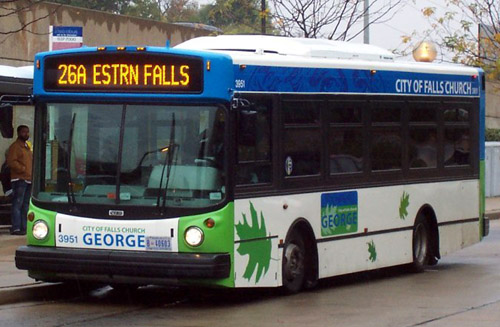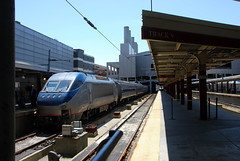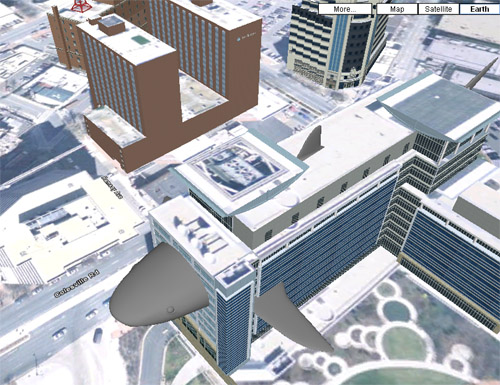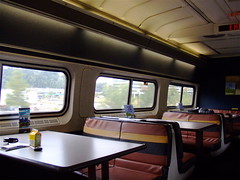|
Special Features





Image Libraries


|
|
Blog
Falls Church’s GEORGE bus service is closing down. The 8-year-old circulator service between East and West Falls Church Metro stations will run for the last time on September 27.
Bye George. We hardly knew ye.

Image from wikipedia.
Average Rating: 4.4 out of 5 based on 276 user reviews.
August 16th, 2010 | Permalink
Tags: bus, events, transportation

|

Acela NE Regional train at Boston’s South Station. |
For most Americans Amtrak is a curiosity, but for those of us along the east coast it is an actually useful mode of transportation. The three busiest Amtrak stations are New York, Washington, and Philadelphia, after all. So with that in mind, here is BeyondDC’s list of the top Amtrak destinations from DC.
The list is based on a subjective combination of ease of travel via Amtrak and, y’know, whether the destination is a place anybody would want to go.
Number 10: Boston Big city, plenty of frequent trains, Acela the whole way. Boston would be much higher on the list if it weren’t so far. At 450 miles it’s on the outer edge of a reasonable distance for travel by train.
Number 9: Coastal Connecticut From cosmopolitan New Haven to touristy Mystic Seaport, there are plenty of places to go, and it’s on the high-qualify Northeast Corridor.
Number 8: Charlottesville Virginia’s likable college town makes for a perfect day trip. Unfortunately there aren’t many trains, so scheduling can be tough.
Number 7: Williamsburg Ditto Charlottesville, but the train schedule is a little easier.
Number 6: Hudson Valley With light houses and fortresses perched atop rocky riverside embankments, the views are nothing short of stunning. As long as you’re staying south of Albany the trip is easy and relatively cheap. For extra savings, take Amtrak to New York and then use Metro North for the second leg.
Number 5: Atlantic City OK, you have to transfer to a New Jersey Transit train in Philly, but that ain’t no thang.
Number 4: Richmond At two-and-a-half hours it’s a comfortable ride, and even though it’s south of DC there are enough trains that scheduling is pretty easy. Use Main Street station rather than Staples Mill for a more urbanistically and architecturally interesting trip.
Number 3: Baltimore Everybody loves the Inner Harbor, right? The only problem with Amtrak to Baltimore is that it’s almost too close. On weekdays those $7 MARC tickets trump the faster but more expensive Amtrak trip.
Number 2: New York America’s unquestioned king of all things passenger rail would be number 1 if the bus from DC wasn’t such a competitive option. Still, there’s something magical about arriving in Penn Station via train (even if Penn Station is a hole).
Number 1: Philadelphia It’s a relaxing-length ride along the high-quality Northeast Corridor, and it’s to a fun city. Amtrak is always my mode of choice to the City of Brotherly Love.
Dishonorable Mentions: Amtrak is what it is, and so even though we’re on the east coast there are some nearby destinations that *should* be easy to reach via train, but unfortunately aren’t. Pittsburgh is almost exactly the same distance from DC as New York, but the one train there per day dumps you off in the middle of the night and is essentially unusable. Harrisburg is as close as Richmond and has decent Amtrak service, but you have to go out of the way to Philadelphia and then backtrack to use it. Norfolk and Virginia Beach are too far from the Newport News station for it to be very useful, although that is due to be fixed.
Average Rating: 4.6 out of 5 based on 212 user reviews.
August 13th, 2010 | Permalink
Tags: intercity, top10, transportation

The website for Capital Bikeshare is now fully operational and accepting memberships. As a special introductory offer, annual memberships that will usually be priced at $75 are currently being sold for $50, and the first 2, 000 people to sign up will receive a t-shirt.
Bikes will be available for rental in DC and Arlington beginning in September.
Average Rating: 4.8 out of 5 based on 174 user reviews.
August 11th, 2010 | Permalink
Tags: bike, transportation

Rob Pitingolo is an urbanist blogger from Cleveland who recently moved to Arlington, and has been contributing to GGW. Yesterday on his blog, Extraordinary Observations, he curiously noted that so many Washingtonians complain so loudly about the Metro, despite it being one of the best transit systems in America by any objective measure.
Pitingolo posed the question What’s the root of DC’s hatred for Metro?
He went on to reason the answer is that:
So many people use (transit) here that there are a whole lot more opportunities to hear from people that don’t like it. In Cleveland, the same types of professionals who get frustrated with ‘hot cars’ and delayed trains and rude station managers (in Washington) simply aren’t using public transit.
He makes a good point, that transit is an integrated part Washington’s culture in a way that it is not in other cities, but that’s only half the answer. The other half is that Metro just isn’t as good as it used to be, simply because it’s aging, and many of us remember when it was new and perfect.
Metro is only about a generation old. It was planned and built since most of its riders have been alive, and for its first couple of decades, nothing went wrong. The maintenance and safety problems that have plagued Metro this decade are for the most part new events, consequences of an aging system that we simply didn’t have to deal with until recently.
Like Pitingolo, I came to the Washington region from Ohio. I was 8 years old in 1989 when my family moved from suburban Columbus to Gaithersburg. But the Metro I was first introduced to was brand new, without a stopped escalator or single-track segment to be found. Shady Grove had just opened five years earlier. At the time, with precious few other rapid transit systems having been built since before World War II, Washingtonians liked to claim that Metro was the best subway in the world.
Really. People said that. Best in the world.
Things have, inevitably, changed. Escalators get old. Tracks crack. Repairs have to be made. Older infrastructure requires maintenance that is often inconvenient to riders. These are facts of life, dealt with by every infrastructure agency in the world, but they are facts that Washingtonians didn’t have to think about until recently.
We remember the good ol’ days, and so these days of problems sting especially sharp.
 Cross-posted at Greater Greater Washington. Cross-posted at Greater Greater Washington.
Average Rating: 4.9 out of 5 based on 210 user reviews.
August 10th, 2010 | Permalink
Tags: metrorail, transportation

The Discovery Building shark in Silver Spring is a lot of fun. Thanks to a tip from IMGoph we know that fun-loving Google is in on the joke. If you go to Google Maps, zoom in the Discovery Building in Silver Spring, and select the “Earth” option (of just click here), this is what you get:

Why shouldn’t we have fun with architecture and urban design? Good going, Discovery.
Average Rating: 5 out of 5 based on 173 user reviews.
August 9th, 2010 | Permalink
Tags: fun

Yesterday during an interview on the Kojo Nnamdi show DDOT director Gabe Klein left the door open to potentially continuing in his post if Vincent Gray wins the upcoming DC mayoral election. In today’s installment of the Washington Post Local Blogging Network, I suggest that Gray could make urbanist voters much more comfortable with his candidacy by publicly declaring support for Klein and his vision for DDOT.
Average Rating: 4.5 out of 5 based on 214 user reviews.
August 5th, 2010 | Permalink
Tags: government, transportation, washpostblog

Every morning rush hour while waiting for the 16th Street bus I watch a steady stream of cyclists fight through the motor traffic to bike south towards downtown.
One block to the west, 17th Street is one-way going south and is much lighter with cars. One block to the east, 15th Street has the city’s best on-street bike facility, the south-bound cycle track. Both are excellent streets on which to cycle, while 16th Street is a high-speed and dangerous maze of cars, buses and trucks.
Why in the world would anybody want to bike on 16th when such excellent alternatives are so easily accessible? While it’s true that neither 15th nor 17th go as far north as 16th, surely the ease of cycling on either of those streets makes it worth the trouble of cutting over a block once possible, doesn’t it?
I don’t begrudge any cyclist their fair place on the street, but as someone who treats his bike as a tool for transport, I always prefer the easiest route possible. When I bike to work instead of ride the bus, which I do occasionally, I use 17th.
So help me out here. I’m befuddled. Why would any cyclist choose to ride south on 16th Street at the height of morning rush hour?
Update: According to comments here and via twitter, 16th Street is much faster. If you’re comfortable with the mixed traffic, you get there quicker via 16th.
Average Rating: 4.5 out of 5 based on 182 user reviews.
August 5th, 2010 | Permalink
Tags: bike, question, transportation

|

This is worth about $50 to me.
Photo by Kynan Tait. |
What’s the best way to get between New York and Washington?
Depends how you define “best”, of course. Just about everybody knows that the cheapest way to do it is via bus, but cheapest isn’t always best. For the extra price of an Amtrak ticket you get more seating space, nicer and bigger bathrooms, a faster ride (even on the slow train, never mind Acela), the ability to get up and walk around, and a cafe car. Buses these days are pretty nice, but they’re not nearly as comfortable as Amtrak.
So just how much extra cash is that comfort worth?
It’s usually about $20 one-way on a bus and $100 one-way on Amtrak’s NE Regional train. For a round trip, that’s a difference of $160. If you’re traveling with a partner (as I usually am), then that’s a round-trip two-person cost difference of $320. I like the cafe car, but not that much. For those prices, I’ll take the bus every time.
But what if the price difference were less? How much closer would it have to get for Amtrak to start looking reasonable?
It so happens that this weekend I’ll be driving up to New York with family, but coming home alone and without a car. For that one-way, one-person trip, the cost difference between Amtrak ($100) and bus ($20) isn’t as severe. It isn’t negligible though. $80 still seems like too much, at least on my budget.
However, I’ll be traveling fairly late at night, and Amtrak’s night discount is bigger than Bolt’s. The train I want is only $74, while the bus I want comes out to $23. That’s a difference of only $51. That cafe car is looking a lot more attractive now.
After thinking about it a few minutes, I booked on Amtrak. Being able to walk around, use a nice restroom, and get food when I want was worth the extra $51 to me, but just barely. If the difference had been much more I don’t think I could have justified it to myself. $30 difference: Done in a heartbeat. $60 difference: I’m not so sure.
What would you do? How much extra will you pay for the luxury of a train?
 Cross-posted at Greater Greater Washington. Cross-posted at Greater Greater Washington.
Average Rating: 4.7 out of 5 based on 162 user reviews.
August 3rd, 2010 | Permalink
Tags: intercity, transportation

|
Media





Site
About BeyondDC
Archive 2003-06
Contact
Category Tags:
Partners
|



















